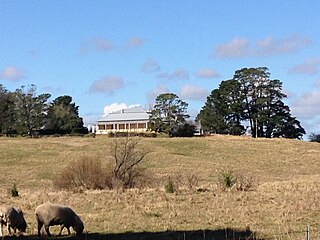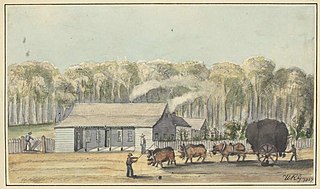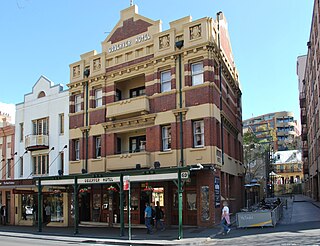
Rosedene is a cottage built as part of the Great Dodford Chartist settlement. It is the best preserved example of a Chartist cottage built by the National Land Company [1] is a listed building, [2] and is owned by the National Trust. [3]

Rosedene is a cottage built as part of the Great Dodford Chartist settlement. It is the best preserved example of a Chartist cottage built by the National Land Company [1] is a listed building, [2] and is owned by the National Trust. [3]
The cottage was built on Plot 29 of the settlement, and was bought by William Hodgkin. He paid £120 as a “bonus” (deposit discounting future ground rents) to secure the property, and another £130 to buy out the property from ground rent when the National Land Company was dissolved. This is the largest amount paid for a plot in a Chartist village. [1]
The original building had two bedrooms, a living room, dairy, store, back hall with well and pump, plus an adjoining piggery, coal house and privy. [1]
Alterations were made to the cottage. A stable was added before 1889, to help carry market garden produce (strawberries, pears and plums) to market in Birmingham. The piggery was converted to a laundry some time between 1915–20, probably as keeping pigs was less necessary as the village’s market garden economy was reasonably profitable. Alterations were made in the 1930s to include an extra bedroom in place of the old store and a new kitchen where the laundry room was, as well as new sitting room where the dairy had once been. [1]
The building was bought by the National Trust in 1997. A donation of £1,000 was made by the Bromsgrove Society in 1999. [4]
The cottage was restored to its original state by the Trust and was helped by long-time resident Mrs Florence Crane. The Trust retains a recording of her recollections of living in the property in their archives.
Rosedene now includes an organic garden [5] and retains its plum and pear orchards. [1] Tours can be made on the first Sunday of the month, between 6 March and 4 December by appointment, or otherwise by arrangement. [5]

Anne Hathaway's Cottage is a twelve-roomed farmhouse where Anne Hathaway, the wife of William Shakespeare, lived as a child in the village of Shottery, Warwickshire, England, about 1 mile (1.6 km) west of Stratford-upon-Avon. Spacious, and with several bedrooms, it is now set in extensive gardens.

Bromsgrove is a town in Worcestershire, England, about 16 miles (26 km) north-east of Worcester and 13 miles (21 km) south-west of Birmingham city centre. It had a population of 34,755 in at the 2021 census. It gives its name to the wider Bromsgrove District, of which it is the largest town and administrative centre. In the Middle Ages, it was a small market town, primarily producing cloth through the early modern period. In the eighteenth and nineteenth centuries, it became a major centre for nail making.

Speke Hall is a wood-framed wattle-and-daub Tudor manor house in Speke, Liverpool, England. It is one of the finest surviving examples of its kind. It is owned by the National Trust and is a Grade I listed building.

The Norman Lindsay Gallery and Museum is the former residence and farmlet of Australian artist Norman Lindsay. Now an art gallery, tourist attraction and museum located at 14–20 Norman Lindsay Crescent in the Blue Mountains town of Faulconbridge in the City of Blue Mountains local government area of New South Wales, Australia, it was built from 1898 to 1913 by Francis Foy, Patrick Ryan, Lindsay, and the artist's wife, Rose Lindsay. The property, owned by the National Trust of Australia (NSW), is also known as Maryville and Springwood.

Royal Lodge is a Grade II listed house in Windsor Great Park in Berkshire, England, half a mile north of Cumberland Lodge and 3.2 miles (5.1 km) south of Windsor Castle. The site of homes since the 17th century, the present structure dates from the 19th century, and was expanded in the 1930s for the then Duke of York, the future King George VI. Its central section consists of three storeys, with two-storey wings, totalling about 30 rooms, including seven bedrooms. The Royal Chapel of All Saints was built on the grounds in the 1820s.

Elizabeth Farm is a historic estate located at 70 Alice Street, Rosehill, a suburb of Sydney, New South Wales, Australia. Elizabeth Farm was the family home of wool pioneers John and Elizabeth Macarthur. The estate was commenced in 1793 on a slight hill overlooking the upper reaches of Parramatta River, 23 kilometres (14 mi) west of Sydney Cove. The Burramattagal clan of the Dharug people are the traditional custodians of the area; their presence is recalled in the name Parramatta.

Vaucluse House is a heritage-listed residence, colonial farm and country estate and now tourist attraction, house museum and public park, formerly the home of statesman William Charles Wentworth and his family. It is located at 69a Wentworth Road, Vaucluse in the Municipality of Woollahra local government area of New South Wales, Australia. Completed between 1803 and 1839 in the Gothic Revival style, its design was attributed to W. C. Wentworth and built by Sir Henry Browne Hayes and W. C. Wentworth. The property is owned by the Historic Houses Trust of New South Wales, an agency of the Government of New South Wales. The site was added to the New South Wales State Heritage Register on 2 April 1999.

Dodford is a village in the Bromsgrove district of Worcestershire, England, approximately 3 miles (4.8 km) west of Bromsgrove, officially founded on 2 July 1849 by members of the Chartist movement. It was one of five settlements created in the land scheme and retains a characteristic grid street plan, along with narrow lanes and many plum and pear trees from its market gardening past. The civil parish of Dodford with Grafton has a population of 731.
The National Land Company was founded as the Chartist Co-operative Land Company in 1845 by the chartist Feargus O'Connor to help working-class people satisfy the landholding requirement to gain a vote in county seats in Great Britain. It was wound up by the National Land Company Dissolving Act 1851.

Grafton Manor was established before the Norman Conquest. Grafton means "settlement at or near the wood" and may indicate a role in woodland management within a larger estate, for instance.
Benjamin Bomford was a prominent Worcestershire farmer in the mid-19th century. He joined the Royal Agricultural Society in 1847 while living at Great Dodford which he later sold to the Chartist National Land Company.
Gladstone House and Cottage is a heritage-listed detached house at 1B–3 Gladstone Street, Newtown, Toowoomba, Toowoomba Region, Queensland, Australia. It was designed by Harry Marks for himself and built c. 1908. It is also known as St Rest. It was added to the Queensland Heritage Register on 13 January 1995.
Barunah Plains Homestead is a heritage-listed homestead at 4484 Hamilton Highway, Hesse, Victoria, Australia. The original house, which was designed by architects Davidson and Henderson, dates from 1866; subsequent additions and alterations were made in the late nineteenth century and in the 1900s-1910s. The homestead also comprises large formal gardens, a bakehouse and laundry, stables, coach-house and implement shed, a woolshed, two bluestone cottages north-east of the homestead, and a ram shed located 1 km south.
Dodford Priory was a small Augustinian monastery in the parish of Bromsgrove in Worcestershire in the current village of Dodford.
The Rosedale Cottage is a heritage-listed residence at Mount Street, Murrurundi, Upper Hunter Shire, New South Wales, Australia. It was built from 1845 to 1850. The property is privately owned. It was added to the New South Wales State Heritage Register on 2 April 1999.
Tomago House is a heritage-listed former residence and now house museum and function centre at Tomago Road, Tomago, New South Wales, Australia. It was built from 1838 to 1840. The design has been attributed to Mortimer Lewis. The property is owned by the National Trust of Australia (NSW). It was added to the New South Wales State Heritage Register on 2 April 1999.

Throsby Park is a heritage-listed homestead at Church Road, Moss Vale, Wingecarribee Shire, New South Wales, Australia. It was built from 1820 to 1836. The property is owned by the Historic Houses Trust of New South Wales, but is leased to banker Tim Throsby of Barclays, a descendant of the original owners. It was added to the New South Wales State Heritage Register on 2 April 1999.

The Hassall and Jefferis Cottages are a heritage-listed former inn, coach staging post and children's home dormitory and now residence at Old South Road, Mittagong, Wingecarribee Shire, New South Wales, Australia. It was built from 1827 to 1842 by George Cutter and William Sherwin. It is also known as Cutter's Inn and Cottage No. 8 and Cottage No. 11. It is a surviving feature of the institution variously known as the Mittagong Training School for Boys and Mittagong Farm Home, State Ward Home or Children's Home, although it predated the facility. It was added to the New South Wales State Heritage Register on 2 April 1999.

Buckland Convalescent Home is a heritage-listed former residence and private parkland and now convalescent hospital located at 39 Hawkesbury Road, Springwood, in the Blue Mountains region of New South Wales, Australia. It was designed by Thomas Buckland and McPhee Smith and was built from 1881 to 1934 by Kell & Rigby. It is also known as Buckland Convalescent Home and Garden. The property is owned by The Buckland Convalescent Hospital. It was added to the New South Wales State Heritage Register on 2 April 1999.

Observer Hotel is a heritage-listed hotel at 69 George Street, in the inner city Sydney suburb of The Rocks in the City of Sydney local government area of New South Wales, Australia. It was designed by Halligan & Wilton and built from 1908 to 1909. The property is owned by Property NSW, an agency of the Government of New South Wales. It was added to the New South Wales State Heritage Register on 10 May 2002.